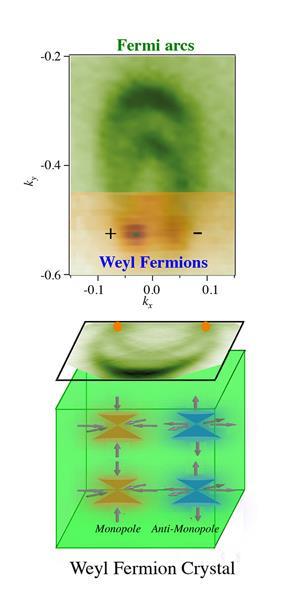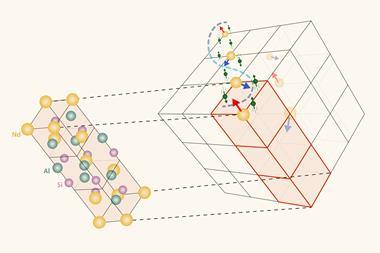Experimental observation of Weyl fermions in a tantalum arsenide crystal ends search after 86 years

Two international teams claim to have found the basic building block of the electron, the Weyl fermion, which was first theorised 86 years ago.1,2 The discovery of this new quasiparticle was not made in a particle collider, however, but inside a synthetic crystal. The fermion, which is massless, could potentially give rise to super-fast electronics and photonics, the discoverers claim.
Weyl fermions are fundamental particles that were first predicted by Hermann Weyl back in 1929, but they have never been observed experimentally. Theoretically, they are observable in materials called Weyl semimetals, which fulfil special conduction and symmetry criteria. Scientists haven’t been able to ever find or make a Weyl semimetal though, because achieving the right electronic structure usually requires fine-tuning the material’s chemical composition. But earlier this year two independent research teams predicted that tantalum arsenide would display Weyl semimetal character without needing any problematic fine-tuning.3,4
Both groups have now followed up on their prediction by making a tantalum arsenide crystal and using it to observe the Weyl fermion. ‘This is the first time ever, in all of physics, that Weyl fermions have been observed,’ says Zahid Hasan from the University of Princeton, US, who is leading one of the groups. The crystal was subjected to angle-resolved photoemission spectroscopy (ARPES), a direct experimental technique used for studying electronic structure. ‘Inside the crystal, electrons behave like they’re massless and chiral,’ Hasan explains, ‘and this is direct evidence of Weyl fermions.’
The fermion may be used to create massless electrons with very high mobility and no backscattering at all. Backscattering from normal electrons greatly reduces electronic efficiency, so the hope is that Weyl electrons can play an important role in the development of new, faster electronics. ‘Tantalum arsenide already has higher mobility than graphene,’ Hasan says. ‘You can create a new kind of electronics, so I’m coining this term: weyltronics.’
‘A new type of electronic system is always potentially interesting,’ says Ashvin Vishwanath from the University of California, Berkeley, US, who wasn’t involved with any of the studies, ‘although it is early days to know how these will be applied. It is worth noting that Weyl materials are direct 3D electronic analogues of graphene, which is being seriously studied for potential applications.’
A third group has just announced that it has observed the fermion in a photonic 3D gyroid crystal, and they also suggest that it could inspire a new generation of photonics.5
Correction: On 29 July the story was amended to describe the Weyl fermion as a quasiparticle












No comments yet